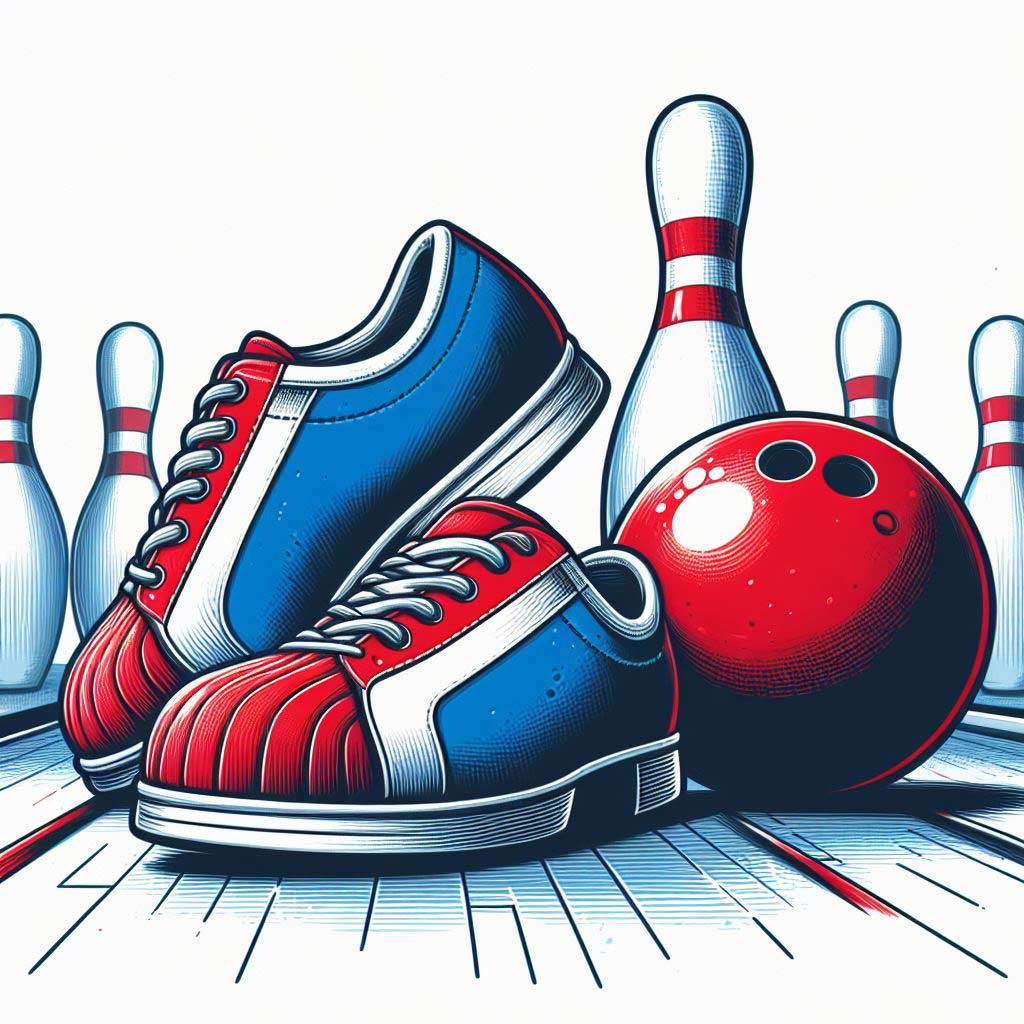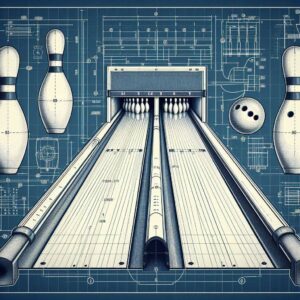Heading to the local bowling alley for some strikes and spares is a classic weekend activity. Part of the fun is putting on your personalized bowling shirt, picking out a colorful ball, and lacing up a stylish pair of bowling shoes.
But have you ever wondered why bowling alleys require you to wear specific bowling shoes instead of your normal street footwear when rolling balls down the slick wooden lanes?
There are actually some very practical and important reasons bowling centers insist patrons slide their feet into a pair of alleys-approved bowling shoes before competing for that elusive perfect 300 game.
Read on to find out the key factors why those bowling shoes are mandatory equipment any time you hit the hardwood.
Protect the Bowling Lanes
One of the biggest reasons bowling alleys demand bowlers use appropriate footwear is to protect their expensive lane surfaces from damage.
Bowling lanes are made from expensive and delicate hardwood like maple that must be maintained in prime condition for ideal ball rolls. They are carefully oiled and polished to provide the proper slide and grip.
The special soles on regulation bowling shoes are designed to glide smoothly over the lane surface without digging into or scuffing the wood. They feature a modest heel and slide made from a soft rubber or microfiber material that will not scratch or peel up the lane’s laminate coating.
Standard street shoes often have rugged soles with pebbles, grit, or imbedded dirt and rocks that could scratch and dent real wood lanes. The preventive measure of supplied bowling shoes guarantees the lanes stay pristine and undamaged.
Reduce Risk of Slipping and Injuries
In addition to harming lane surfaces, typical street shoes can actually be dangerous when worn during bowling.
Unlike bowling shoe soles crafted specifically for sliding across slick wooden boards, everyday shoes and sneakers have hard, flat soles normally intended for traction and grip. Their rubber or leather soles will stick and catch on an oiled lane surface.
Wearing street footwear while bowling significantly increases the chances of slips and falls leading to potential finger, wrist, and leg injuries for both novice and expert bowlers. Supplying appropriate bowling shoes with a defined slide sole provides needed traction and reduces accidents.
Minimize Noise and Distractions for Other Bowlers
When curious bowling newbies show up wearing their regular street shoes, the loud clacking of heel taps and soles often generates annoyed looks from seasoned bowlers.
The soft rubber and suede materials used in regulation bowling shoes absorb sound much better than hard leather dress shoes or rubber-soled sneakers stomping down the lane. This reduces distracting noise in the environment so bowlers can concentrate and other groups can converse.
Improve Bowling Form and Technique
Serious bowlers know the specialized soles of true bowling shoes are designed specifically to facilitate ideal release of the ball.
The defined heel and smooth rubber sole of the non-sliding shoe provide stability and traction when completing the approach. The controlled slick texture of the opposite slide shoe allows the foot to move forward smoothly at the release point without catch or drag.
Attempting slides in stiff street shoes with poor flexibility often impedes proper technique and timing, throwing off alignment and accuracy. The right shoes lead to better slides, releases, and higher-scoring games.
Keep Bowling Area Cleaner
Vigilant bowling alleys also want to minimize patrons tracking dirt, food crumbs, oil, salt, and other grime and debris from outside onto their lanes and carpets. Requiring bowling shoes helps keep their facility looking sharp.
Serious bowlers also appreciate a clean approach and foul line to execute the perfect strike shot without worrying about sticky spills or pebbles affecting their speed and footwork rhythm.
Differentiate Professionals from Amateurs
For hardcore league and tournament bowlers, the correct footwear is about more than keeping lanes tidy and reducing noise. It’s a sign of a serious player.
Custom-fitted bowling shoes with advanced sliding soles and heels represent a bowler’s dedication, knowledge, and status in the sport. It also shows understanding and respect for the specialized lanes and culture.
Requiring shoes rented from the alley on league nights or tournaments allows professionals to spot amateur participants immediately at first glance based on their footwear. It maintains an extra standard and ritual for competitive events.
Key Considerations When Selecting Bowling Shoes
Now that you know why you have to wear bowling-optimized footwear, how do you pick the right bowling shoes for your feet and playing style?
With hundreds of options out there from brands like Dexter, Brunswick, Etonic, and more, it can get overwhelming attempting to choose your ideal set of bowling kicks.
Here are the key factors to consider:
- Comfort and Fit Well-cushioned insoles, shock-absorbing inserts, and advanced ventilation systems reduce foot fatigue and discomfort through marathon bowling sessions. Be sure to try on shoes and walk around before purchasing or renting. Properly fitted street shoe size often translates to bowling shoes.
- Slide Sole Material The majority of bowlers opt for slide soles made of rubber, urethane, or microfiber that provide the right blend of slide and traction. More advanced players may prefer leather outsoles for greater sliding speed.
- Heel Height
Higher heel heights between 1 – 2 inches aid support in the approach steps. Flatter heels allow more experienced bowlers to stay closer to the lane. Make sure the pitch feels balanced. - Interchangeable Soles Higher end shoes offer the ability to change slide pads and heels to match bowling style and lane conditions. This level of customization maximizes scoring potential.
- Ventilation Well-ventilated shoe models help feet stay cool and comfortable during extended bowling activity and reduce odor. Look for moisture wicking linings and uppers as well.
- Ankle Support Many shoes provide optional adjustable laces, padded collars, or velcro straps to increase lateral ankle stability during approaches, slides, and stops.
- Durability With the repetitive slides and stops that come with bowling, durability is also key. Look for sturdy uppers, high abrasion rubber outsoles, and reinforced stitching.
- Style Preferences Personal style absolutely plays a role. You want to feel confident and stand out in colors and designs you love. Youth bowlers may gravitate towards flashy neon accents for example.
Ultimately, the ideal bowling shoes come down to fit, comfort, performance, and taste to compliment your game. Don’t be afraid to try on different options until you find your perfect match.
Breaking in New Bowling Shoes
Fresh out of the box bowling shoes will naturally feel stiff and tight. Taking the time to properly break-in your new kicks helps maximize bowling shoe lifespan and prevent painful blisters.
Here are some handy tips to break-in bowling shoes for comfort and peak performance:
- Wear the Shoes at Home – Try on your new bowling shoes at home to begin forming to your feet before taking them on the lanes.
- Use a Shoe Stretcher – Shoe stretchers with a molded shape gently extend and widen shoe uppers.
- Apply Leather Conditioner – Treating leather uppers keeps material supple and speeds break-in.
- Consider Inserts – Custom orthotics or padded insoles can improve snug fits during early wear.
- Gradually Wear for Longer Periods – Slowly increase how long you wear new bowling shoes to ease into full games.
- Bring Backup Shoes – Carry an extra comfortable broken-in pair as backup until primary shoes form better.
- Wear Thick Socks – Extra sock cushioning prevents blisters from stiff spots and seams.
- Address Potential Pain Points – Use moleskin, gel pads or tape on any hotspots like heels before they blister.
- Ask the Pro Shop for Advice – Technicians at pro shops are experts on how to break-in bowling shoes for maximum comfort.
Stick to those handy bowling shoe break-in guidelines above and you’ll be knocking down pins in personalized comfort in no time!
Caring for Your Bowling Shoes
Of course, the work doesn’t stop after you break-in those new bowling shoes. To maintain top performance and extend the life of your footwear investment, proper bowling shoe care and cleaning is essential.
Here are pro tips for keeping bowling shoes in primo condition:
- Remove Debris – Carefully remove any debris lodged in slide soles after bowling.
- Wash and Disinfect – Use mild soap and water to gently clean bowling shoe uppers and linings. Disinfectant spray kills odor and bacteria.
- Dry Thoroughly – Always allow shoes to completely air dry between wearings to prevent moisture damage.
- Apply Leather Conditioner – Nourish and protect leather uppers with periodic conditioner.
- Adjust Laces – Ensure laces aren’t too tight restricting foot expansion when heated up.
- Use Shoe Deodorizers – Powders, sprays, and foam insoles help eliminate shoe odors between deep cleanings.
- Inspect Slide Pads – Check slide soles for tears, excess wear, and smoothness. Replace as needed.
- Spot Clean Scuffs – Use a melamine foam cleaner to erase stubborn lane scuffs on shoe uppers.
- Store Properly – Keep bowling shoes in breathable bags with cedar blocks or moisture-absorbing packs when not in use.
- Replace Insoles – Worn out insoles cause discomfort and uneven wear. Replace twice a season.
- Get Annual Maintenance – Take shoes to the pro shop annually for a full servicing and repairs to keep them bowling ready.
- Consider Resoling – When slide pads wear thin or uneven, professional resoling restores performance.
With consistent care, quality bowling shoes can deliver seasons of strikes, spares, and high scores before needing replacement. Don’t neglect their cleaning and maintenance needs.
Bowling Shoe Etiquette and Rules
As important as selecting the perfect pair of bowling shoes is knowing the proper etiquette and rules for wearing them on the lanes.
Here are the key bowling shoe etiquette guidelines to follow:
- Always Wipe Shoes – Be sure to wipe shoe bottoms thoroughly before stepping on lanes to avoid transferring dirt or debris.
- Never Walk Outside in Bowling Shoes – Don’t wear rented bowling shoes outside as they have special soles unsuitable for concrete or rough surfaces.
- Don’t Alter Slide Soles – It’s prohibited to modify slide soles in any way by adding substances or physically altering. This maintains fair play.
- Avoid Food and Drink Near Shoes – Be careful eating and drinking around bowling shoes to prevent damaging spills or stains.
- Be Courteous in Shared Pairs – When sharing a pair, be careful not transfer fungus or odors to shared bowling shoes with disinfectant spray.
- Report Damage Immediately – Alert staff right away if a rented pair of bowling shoes develops any problems or defects during play.
- Follow Return Policies – Double check return policies and make sure to bring shoes back on time to avoid additional rental fees.
Respecting bowling alley footwear rules and practicing proper bowling shoe etiquette makes the experience more enjoyable for everyone. It also ensures rented bowling shoes remain in top shape for years to come.
Conclusion
Hopefully this complete guide answered all your burning questions about why bowling alleys universally require players to suit up in specialized footwear before taking to the hardwood.
The short reason is that bowling shoes protect valuable lane surfaces, minimize risks, reduce noise, keep centers cleaner, and provide the traction and slide soles vital for bowling with power and finesse.
So next time you lace up those unique shoes with the iconic slid sole before bowling, you can appreciate all the design, engineering, and purpose that goes into proper bowling footwear.
Remember to break new shoes in gradually for comfort, clean and care for them regularly, and follow proper etiquette. Most importantly, have fun out there rolling strikes! With the right shoes, you just may hit that elusive 300 game.
Frequently Asked Questions
Can you wear regular shoes at a bowling alley?
Most bowling alleys do not allow regular street shoes on the lanes. The special rubber soles of bowling shoes are designed not to damage the wood lanes. Normal shoes also increase the risk of slipping on the polished lanes. Renting bowling shoes is required in most centers.
Can I bowl without bowling shoes?
Bowling barefoot is never allowed, as feet need slide soles and the traction of bowling shoes for safety. Bowling in just socks is also prohibited. Some places may make rare exceptions for children wearing socks only.
Why do bowling alleys have their own shoes?
Bowling centers keep stocks of rental shoes to guarantee the proper footwear is worn to protect lanes. It also ensures shoes are cleaned, disinfected and maintained for guests. People are not allowed to bring street shoes that could scratch and damage the bowling surface.
Why do you need bowling shoes for bowling?
The rubber soles and defined slide of bowling shoes enable the motions needed in bowling like the approach, slide, and release. The traction also minimizes the risk of slipping on slick lanes. Bowling technique and safety require the appropriate footwear.
Is there an alternative to bowling shoes?
There are no adequate alternatives to standard bowling shoes with defined slide and walking sole. Some places may allow athletic shoes that at least have non-marking soles, but rental shoes are the safest option.
Can you bowl in Converse?
Converse and other flat rubber-soled athletic shoes do not provide the same slide control and traction as bowling shoes, but some alleys may permit them as long as the soles are clean. They are not ideal substitutes.
Can I bowl in regular shoes?
Most bowling centers prohibit street shoes, including leather dress shoes, boots, sandals and hard rubber sneakers because they damage lanes and don’t slide properly. Always call ahead to ask about shoe policies.
Can you go bowling in Crocs?
No, the foam and rubber of Crocs could severely damage bowling lanes. The molded plastic also provides no traction and braking ability needed for bowling motions. Bowling shoes must be worn.
Can you wear open toed shoes to bowl?
Open toed shoes like flip flops are banned at most bowling alleys for safety reasons. Toes need to be properly protected by closed toe athletic shoes or bowling shoes during the motions of bowling.





